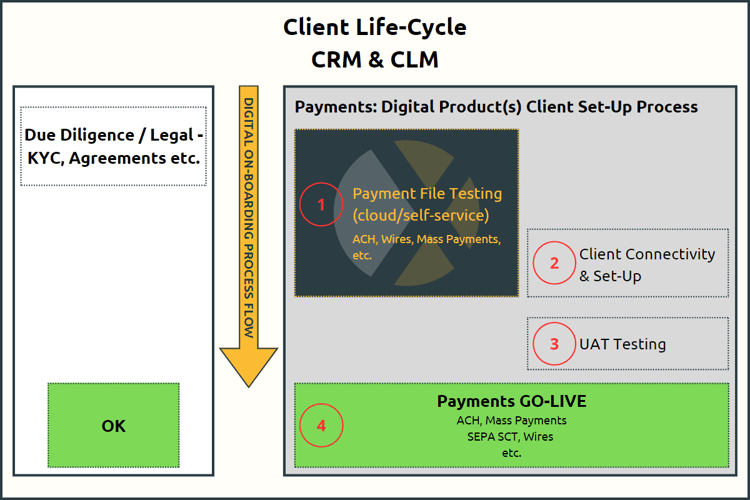On-Boarding: Automation of the Client Journey
A running joke among bankers is, the first thing you do with a new client is annoy them. The entire on-boarding process, from KYC (know your customer) and other due diligence (sanctions, AML, etc.), then the completion of service agreements (with the bank), any legal stuff, and the set-up of the client on the bank’s systems – it all takes time, and demands a lot of interaction with the client. And it’s not necessarily the kind of agreeable, enjoyable client interaction that we all like.
After the compliance and legal steps are complete, the last phase of client on-boarding is the technical integration of client and bank systems. This phase is too often still highly manual, and takes too long. Also annoying.
In our blog, “Getting It Over the Line” we showed how this last phase can be done faster and with less effort, improving the client experience.
All this is not necessarily the bank’s fault. The first part of the on-boarding process is driven by regulation and compliance concerns; financial institutions have a duty to know who they are dealing with, which creates the need to collect, verify and evaluate client information – forming the evidentiary (and auditable) basis for a ‘go’ decision with the client.
The whole process is cumbersome because much of the work involves collecting and analysing information from the client, starting with whatever data is already in the bank’s CRM, followed by gathering (and completing, with signatures) a whole range of updated documents. These are often still in unwieldy paper form, but can also be exchanged electronically as PDFs (or other digital document formats) which is better than paper – but also requires handling.
And finally, the technical integration mentioned above, where the exchange of data (for payments, and all kinds of reports) between the bank and the client’s ERP, Treasury and other systems is agreed.
And tested. And tested … and tested. Which is necessary, but can be automated with a SaaS testing platform that provides fast, actionable feedback to get things to work. Less annoying!

The challenge – how can the bank meet compliance requirements and also build a more (dare we say) “pleasant” client experience?
The diagram above shows how early in the overall on-boarding process the client can use a self-service platform to start with the testing of payment messages. Here is how the process would work.
New customer (or new service for an existing customer) is logged in CRM.
For Due Diligence & Legal, the CRM (for example) sends notification to a CLM system (CLM or client life-cycle management which helps orchestrate the set-up process) to kick-off necessary regulatory and compliance checks, generate product and any other agreements needed, etc.
For the Client Set-Up, CRM also notifies the CLM to kick off the Payments product implementation, which then triggers:
- Registration in Payment File Testing (PFT) system (cloud) – for client self-service testing;
- Set-up in Bank production and connectivity systems (after legal and compliance OK);
- UAT and go-live, once PFT and connectivity are OK.
From our perspective the key is that the client can get ready with PFT independently, in self-service mode. During the PFT phase, the client can view message format specs and sample files, perform validation, and can even simulate message flows, while the client’s progress can be monitored by the bank.
CLM (client or customer lifecycle management) systems are designed to track and help manage client activity throughout different stages of a client’s lifecycle (or relationship) with the bank – and have started to expand their products to cover customer lifecycle stages beyond the legal and compliance parts of the on-boarding process. Some CRM platforms (like SalesForce) are expanding their products to encompass more CLM functionality as well.
For a more complete self-service on-boarding process, the CLM should also cover the important activities in the last technical integration phase: payment file format testing, bank connectivity setup and bank UAT testing. The CLM system can ensure a smooth customer journey through this phase by automatically triggering actions in the relevant systems at the right moment for the client. For payment file format testing activities, the CLM can trigger a registration process for the client in the XMLdation service, and prompt the service to configure only those bank products that a client decides to use. Clients are then free to prepare and test their file formats in their own time, providing speed and CX (customer experience) benefits as part of the self-service on-boarding process. Completion of payment file testing, combined with completion of bank connectivity setup can be the trigger points for entry into the bank UAT phase. All making it easier and faster for clients to get started. Less annoying!
XMLdation works with banks and clearing systems – and for both, our service can be part of a complete, automated self-service on-boarding process. As mentioned, the goal is to allow clients (or clearing participants) to work at their own pace, with visibility and continuous feedback, from compliance through to technical integration. Our comprehensive format testing helps to greatly enhance client experience (CX) at lower cost, with faster time to revenue.
In contrast to CRMs, corporate-to-bank connectivity solutions, and treasury solutions, XMLdation offers a well-structured, automated client implementation process. XMLdation can also enhance customer experience as part of a transparent troubleshooting and monitoring process.
In the end, most bankers (and of course their clients) would understandably appreciate an easier on-boarding “journey”, so they can focus on more important relationship matters … like doing more and better business!
Want to know more about our Payment File Testing Solutions? Read more here.
About XMLdation
XMLdation is a world leader in financial messaging. Our solutions are designed for banks and clearers.
Our solutions Request a demo today Subscribe to our newsletter

